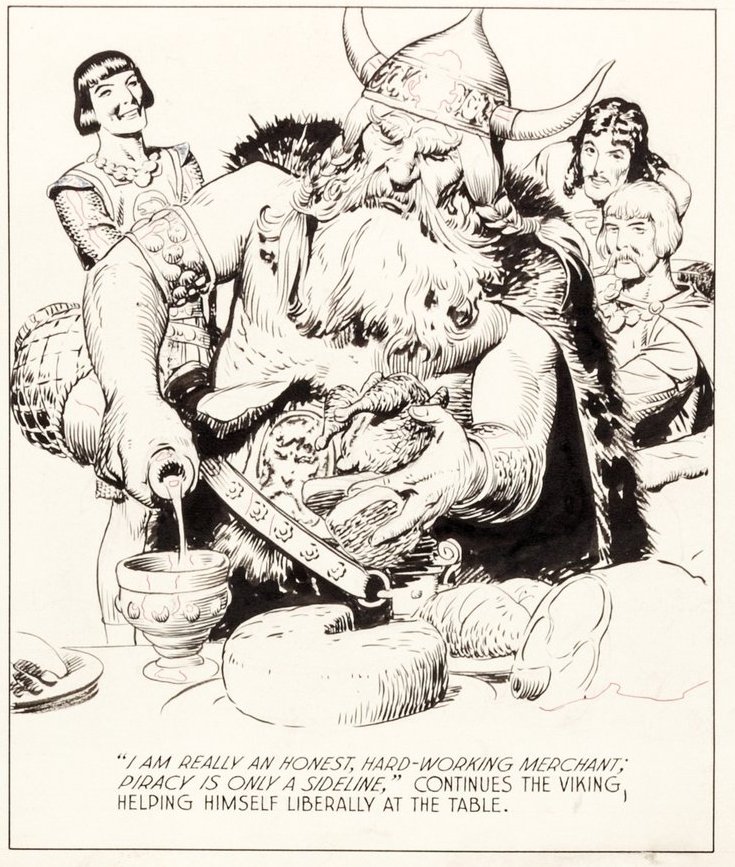
By Jim O’Neal
On a calm day in June 793, a group of men landed on the Holy Island of Lindisfarne in northern England and mounted a ferocious attack on the monastery. The invaders murdered some of the monks, dragged others into slavery and plundered the church’s treasure.
This surprise assault is the first recorded raid by Vikings – pagan, seafaring warriors from Denmark, Norway and Sweden – and it sent waves of horror and fear across Christian Europe. Vikings would go on to ravage and loot large parts of the continent, however, they were also traders and colonists with a sophisticated artistic culture.
Within six years of the attack on Lindisfarne, bands of Vikings – or “Danes,” as they were known in Anglo-Saxon England – were targeting the wealth of other Christian sites in England, Scotland, Ireland and France. They had a significant advantage on these missions: the Viking longship. This was a slender vessel with a shallow bottom that enabled them to sail far up the waterways and surprise their prey.
Each ship could carry 80 warriors, recruited by warlords whose authority flowed from their prowess and reputation for capturing booty for their followers. They were the most skilled shipbuilders, sailors and navigators in the Western world.
Around 800, they colonized the Faroe Islands and used them as a stepping stone to explore the entire North Atlantic region. Eventually, they reached Iceland, where settlers founded a colony that became politically independent. They exiled Eric the Red and he stumbled upon Greenland and established yet another new colony.
A Norse saga describes how Eric the Red’s son, Leif Erikson, was driven off course and landed in a region, teeming with hardwood forests and wild grapes, that he named Vinland (Land of Wine). However, subsequent expeditions were thwarted by indigenous people in an area now identified as Newfoundland in eastern Canada. Leif and his crew get credit for being the first Europeans to set foot on North American soil.
By the 11th century, the Scandinavian kingdoms had adopted Christianity and turned from raiding and pillaging to organized settlement. Cnut the Great of Denmark created a North Sea Empire that included Denmark, Norway and England, but it did not survive his death. In 1066, an unsuccessful attempt to claim the English throne by the Norwegian King Harald Hardrada was the final flourish of the Viking Age.
From the narrow view of history, it is fascinating to contrast the “marauding, pillaging, warrior tribes of Viking raiders” to the serene, peaceful land of Scandinavia, with its breathtaking fjords and unique form of European socialism that the people seem to thrive on. Our world has rarely seen such a silent transition and it makes one wonder which direction we are headed.
Today, we certainly see remnants of Viking culture all around, with comics (Hagar the Horrible), the superhero Thor (thanks to Stan Lee and Marvel Comics), the 1958 Kirk Douglas movie “The Vikings,” and, of course, the unforgettable Purple People Eaters of the Minnesota Vikings, who’ve played in four Super Bowls.
 Intelligent Collector blogger JIM O’NEAL is an avid collector and history buff. He is President and CEO of Frito-Lay International [retired] and earlier served as Chairman and CEO of PepsiCo Restaurants International [KFC Pizza Hut and Taco Bell].
Intelligent Collector blogger JIM O’NEAL is an avid collector and history buff. He is President and CEO of Frito-Lay International [retired] and earlier served as Chairman and CEO of PepsiCo Restaurants International [KFC Pizza Hut and Taco Bell].
